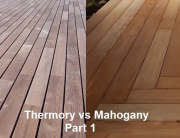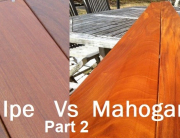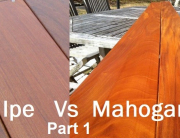Plastic VS Wood decking
PVC/Plastic decking health concerns
- PVC decking is being sold and purchased throughout the world because majority of the public is unaware of its harmful effects.
- Unlike Mahogany or Hardwood Decking, PVC is not a sustainable, “green” building material. Its prolonged exposure is likely to cause drastic health and environmental complications that may be irreversible, such as toxic chemical exposure and fire hazards. In fact, the harmful toxins found in PVC are found to cause and aggravate life-threatening diseases like skin cancer, immune system diseases, and hormone disruption.
- Chlorine– In the United States alone, production of PVC consumes almost 40 percent of the total chlorine use. Chlorine is one of the deadliest toxins to affect living beings. Evidence suggests that the toxic chemical can be directly linked to fertility and development problems in humans and animals.
- Combustion– Fire accidents can become even more harmful because of Plastic decking, because the material can release corrosive fumes on combustion. Hydrochloride gas, one of the by products of Plastic combustion, is extremely lethal when inhaled.
PVC Decking False Advertising
- Plastic decking is a “no maintenance alternative” – Nothing is maintenance free – once any product wood or plastic is placed outside it will need annual maintenance. Plastic can develop mold and when charged by the heat dirt and dust will sit on the surface. If your clients are looking for a “low maintenance product that is natural and environmentally sustainable I would recommend looking into the premium hardwood decking options such as mahogany hardwood. It can be oiled once and then left to weather to a beautiful silvery colour for a low maintenance option.
- Plastic decking “will never need to be replaced once laid down” – Most substructure will rot within 15-20 years and show significant signs of deterioration and probably need to be rebuilt. Thus the life of the deck is truly determined by what comprises it substructure. Using a natural wood product is a better choice because it can be reused if the substructure needs repairs. Whereas plastics won’t be able to be reused and will be tossed in a landfill and take up wards of 1000 years to decompose.
Disposing and recycling PVC
As of today, there is no efficient method for the safe disposal of PVC. Reports published by the Environmental Protection Agency suggest that in the United States, only 0.5 percent of post-consumer PVC is reused. The remaining – about 99.5 percent – is usually dumped in landfills or burned away.
If low maintenance, longevity and sustainability are your main reason to choose plastic decking than you probably haven’t heard of Fijian mahogany decking. Stop by your local lumberyard and ask them about our premium mahogany options. Green World Lumber now offers mahogany boards in 5/4×6 – 6-19’ pulled to lengths.





